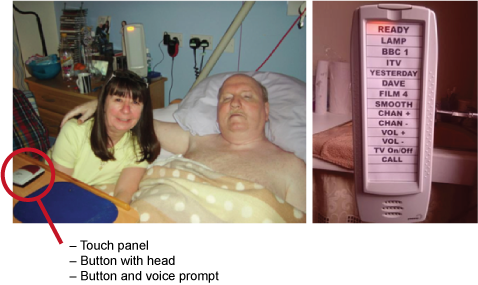How does assistive technology work?
As long as a piece of equipment has either an infrared or a radio signal in an independent living environment, the device can be used by someone with disability. Simply controlled devices such as table lamps can be converted by an adapted plug, which is then controlled by an infrared signal.
In the case of doors, windows, curtains, blinds and light fittings, the most satisfactory way of incorporating the technology is during the building of a property.
Devices can be fitted retrospectively, and while the additional wiring on the walls may not look very attractive, it is better to have the technology than not.
Note: Environmental technology that affects the building will not be funded by NHS assistive technology providers. In the case of supported living, however, depending on location, Social Services may assess the living environment and make adaptations to suit the needs of the patient.
Gaining access to equipment is achieved through a control device in the same way that an able-bodied person would turn on the TV with a remote control. What access is easiest for the individual will determine the type of control device and switch prescribed. When people say that assistive technology doesn’t work for them, access will usually be the problem. For example, the door or window will open and close remotely but the means to open it for that person has not been assessed correctly and is causing problems.
There are many, many controls and switches on the market and consequently choice can be daunting. People choosing assistive devices will need to take into account their condition and whether it is likely to deteriorate, to ensure that the chosen device is the most appropriate one for them.
The next activity will start you thinking about the benefits of assistive technology.
Activity 6
Read the case study below and then answer the question that follows.
Case study: Ray Grocott and his Freeway machine
Ray Grocott lives in a Leonard Cheshire Disability residential service. Figure 5 shows Ray and his wife Diane, and Ray’s Freeway machine. Ray uses a Freeway device, which allows him to, for example, turn on lights, lamp, TV and radio, and to open doors and windows that are connected to his Freeway. As he is unable to hold the device, he can use a switch that can be activated by whatever movement the individual is capable of, such as head, chin, finger, foot and so on.
Diane realised the power of the technology when she was on the phone to Ray one evening. She told him, ‘There’s a great programme on BBC1’. But as she began to explain it to Ray she was interrupted by a voice in the background, ‘Are you ready, Ray…, Lamp…, BBC1’ and they were able to watch the programme together.
Diane travels a lot for work and listens to audio books. She now shares her audio books with Ray who can access them when he wants. This has given them new topics for conversation.
Ray goes home at the weekends. North West Assistive Technology, their NHS assistive technology provider, has duplicated Ray’s system in his own home. When he wakes in the night he can turn on his light and the TV without breaking Diane’s sleep, which makes life so much better for Diane.
Diane said: ‘The Possum Freeway 2 has changed Ray’s life. To lose it now would be like him losing another ability.’
And Val Kirk, Assistant Therapist at Hill House (the Leonard Cheshire Disability care home), said: ‘Being empowered to take back independence which has been robbed from individuals by debilitating illness has improved their whole well-being.’
How do you think assistive technology has benefited Ray and his wife?
Comment
You may have thought about the following:
- The technology has increased Ray’s independence, giving him more control over his life.
- It has enhanced Ray and Diane’s relationship as it enables them to share activities and gives them more to talk about.
- As the technology has been duplicated in his home, Ray can be independent at home and this in turn enhances Diane’s life by giving her a better night’s sleep.

